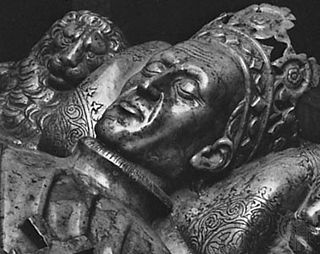Loading AI tools
Jogaila, later [nb 1] (ca. 1351/1362 – 1 June 1434) was Grand Duke of Lithuania (1377–1434), jure uxoris King of Kingdom of Poland (1386–1399), and sole King of Poland (1399–1434). He ruled in Lithuania from 1377, at first with his uncle Kęstutis. In 1386 in Kraków he was baptized as Władysław, married the young queen regnant Jadwiga of Poland, and was crowned King of Poland as Władysław II Jagiełło. In 1387 he converted Lithuania to Christianity. His own reign in Poland started in 1399, upon death of Queen Jadwiga, and lasted a further thirty-five years and laid the foundation for the centuries-long Polish–Lithuanian union. Władysław II was the founder of the Jagiellon dynasty that bears his name, while pagan Jogaila was an heir to the already established house of Gediminids in Grand Duchy of Lithuania; the royal dynasty ruled both states until 1572,[nb 2] and became one of the most influential dynasties in the late medieval and early modern Central and Eastern Europe. During his reign Polish-Lithuanian state was the greatest Kingdom of the Christian world.[1]

Jogaila was the last pagan ruler of medieval Lithuania. After he became King of Poland, as a result of Union of Krewo, the newly formed Polish-Lithuanian union confronted the growing power of the Teutonic Knights. The allied victory at the Battle of Grunwald in 1410, followed by the Peace of Thorn (1411), secured the Polish and Lithuanian borders and marked the emergence of the Polish–Lithuanian alliance as a significant force in Europe. The reign of Władysław II Jagiełło extended Polish frontiers and is often considered the beginning of Poland's Golden Age. (Read more. . .)
- He is known under a number of names: Lithuanian: Jogaila Algirdaitis; Polish: Władysław II Jagiełło; Belarusian: Jahajła (Ягайла). See also: Jogaila (Władysław II Jagiello): names and titles.
- Anna Jagiellon last member of royal Jagiellon family died in 1596.
- Anna Boczkowska, Sarkofag Władysława II Jagiełły i Donatello, Gdańsk 2011, p. 27.
Wikiwand in your browser!
Seamless Wikipedia browsing. On steroids.
Every time you click a link to Wikipedia, Wiktionary or Wikiquote in your browser's search results, it will show the modern Wikiwand interface.
Wikiwand extension is a five stars, simple, with minimum permission required to keep your browsing private, safe and transparent.